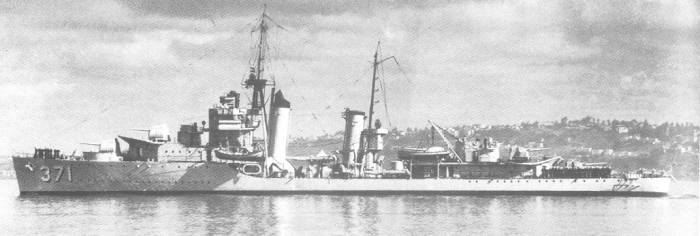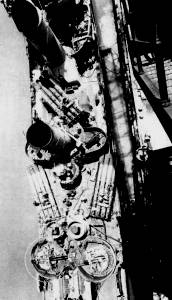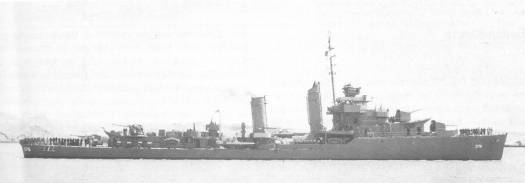

Design History
By March 1933, C&R had prepared designs to compromise between the desires of the General Board for more torpedoes and the CNO's desire to retain the DP gun. In fact, the new design did retain 5 5"L/38 DP guns and did possess twelve torpedo tubes, a result made possible by increasing the beam slightly and restructuring the placement of the armament. One quadruple mount remained on the centerline, while two others were placed in wing mounts abaft the second stack. The no.3 mount was moved aft, directly before the no.4 mount, separated from it only by a low deckhouse, serving as a gun crew shelter.
These aspects of the design were decided on with little problem, and the main feature of the Mahan class would not be found in armament, but in the innards of the ship, in its boilers and engines.
When the design was completed on general terms, the Navy asked Gibbs & Cox of New York to do the design work. Gibbs & Cox much desired to provide the latest engineering advances to the new destroyers, to which the Navy concurred, realizing that advanced destroyers would need advanced engineering if they were to work. Substantial improvements were worked into the ships' power plant. High-pressure turbines with almost twice the pressure of the Farragut class, double reduction gears, 700°F boilers and feed water economizers combined to make a propulsion system of lighter weight and greater efficiency. Although initially chided for its complexity, wartime operation more than proved the reliability and power of the new installment.
With the regular Mk33 gun control equipment, shields for the two forward guns, and four 12.7mm L/90 AA machine-guns, the Mahan class received the standard additions to its main armament; depth charges and tracks were initially not considered desirable, but were soon added.
In 1943, the 20mm and 28mm mounts aft were replaced by two twin 40mm mounts.
Service History
The next loss was Tucker, sinking on a U.S. mine barrier off Espiritu Santo in the prelude of the Guadalcanal campaign. Ships of the Mahan class served in the Solomons campaign, Cushing, part of Admiral Callaghan's force at First Guadalcanal, was sunk, and two nights later, Preston was sunk as part of Admiral Lee's battleship force at Second Guadalcanal. In December 1944, covering the carriers during the post-Leyte operations, Mahan was hit by Kamikazes and sunk, soon later followed by Reid, sunk during the fighting for Ormoc. She was the last war-time loss. All remaining ships were scrapped between 1946 and 1948.
Following the conclusion of the Porter design in late 1932, the General Board reconsidered its designs for the 1,500ton destroyers. Within the Board, there was strong feeling that the 8-tube torpedo set of the Farraguts was not enough; consequently, the Board envisaged a new design to carry at least 12 torpedo tubes. Furthermore, it wanted space reserved for reloads.
 The Bureau of Construction and Repair replied to this request, claiming that it could offer four triple mounts (two on each side, the preferred arrangement of many senior officers), plus five 5" L/38 guns, provided that they be single-purpose. The General Board concurred, but the Chief of Naval Operations, commenting on the idea, crushed it.
The Bureau of Construction and Repair replied to this request, claiming that it could offer four triple mounts (two on each side, the preferred arrangement of many senior officers), plus five 5" L/38 guns, provided that they be single-purpose. The General Board concurred, but the Chief of Naval Operations, commenting on the idea, crushed it.
 Modification History
Modification History
The class received few modifications prior to 1942. That year, the no.3 5" L/38 gun was removed in favor of two 20mm guns, SC air-search and Mk 4 gunnery control radar were installed, and four to five 20mm guns were further sprinkled about the ships. The next year, all ships had received SG surface-search radar, with initial equipment with 40mm twins in place of the earlier installed 20mm in no.3 position. In 1945, two ships, Lamson and Shaw received anti-kamikaze refits, losing their torpedo tubes in favor of more AA.
All ships did serve in carrier and amphibious groups screens, and served in surface action groups. Cassin, Downes, and Shaw suffered damage at Pearl Harbor, Cassin and Downes being completely destroyed in the attack. Parts of their equipment were salvaged and installed in new hulls, retaining their old numbers; however, they can nonetheless be considered war losses.
Ships in class:
DD-364 Mahan
DD-365 Cummings
DD-366 Drayton
DD-367 Lamson
DD-368 Flusser
DD-369 Reid
DD-370 Case
DD-371 Conyngham
DD-372 Cassin
DD-373 Shaw
DD-374 Tucker
DD-375 Downes
DD-376 Cushing
DD-377 Perkins
DD-378 Smith
DD-379 Preston
|
|
Displacements:
Standard: 1,717 tons Full: 2,328 tons Length: 104m / 341ft 3" Beam: 10,81m / 35ft 6 1/8" Draft (Full Load): 4m / 13ft 1 1/4" Crew (Officers/Men): 8 / 150 Endurance: 4,360nm at 20 knots Speed: 37 knots |
|
|
Belt: No belt armor
Deck: No deck armor Barbettes: No barbette armor Conning Tower: No conning tower armor |
|
|
(As designed):
Main: 5 x 127mm L/38, in single mounts: two forward, superfiring, one in front of after deck house, two aft, superfiring Secondary: None AA: 4 x 12.7mm L/90 in single mounts Torpedoes: 12 533mm torpedo tubes in three quadruple mounts, one on the centerline, two on the wings Depth Charges: 2 x depth charge track, 14 depth charges (Reid, July 1943):
(Shaw, August 1945, after AAW1945):
|